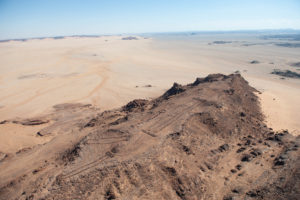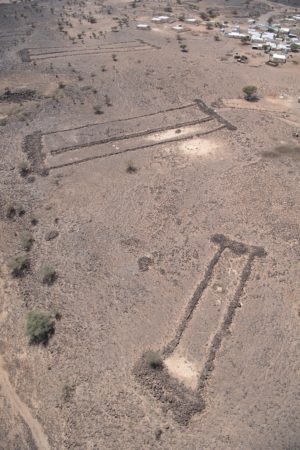
Antiquity: Archaeologists have established ancient people in northwest Arabia built hundreds of large, likely ritual, structures over 7,000-years-ago. This represents the earliest known widespread tradition of monument building, predating the pyramids of Egypt or stone circles of Britain by millennia.
These ritual structures are large rectangular stone constructions that can be over 600 meters long, with a platform at each end. Named ‘mustatils’, after the Arabic word for rectangle, they have long been known about but had been the subject of very little research.
As such, a team of archaeologists from the University of Western Australia, funded by the Royal Commission for AlUla (RCU), set out to change this. They documented hundreds of mustatils by helicopter, explored almost 40 on the ground, and excavated one as part of the largest study of these structures ever conducted.
The results of this research*, published in the journal Antiquity, reveal there were nearly twice as many mustatils in the region as previously thought.
“We documented over 1000 mustatils, covering over 200,000 km²,” said Dr Hugh Thomas, from the University of Western Australia and director of the project.
The ground survey revealed that the structures were more complex than previously believed, featuring distinct entranceways, organized ‘cells’ and standing stones. Radiocarbon dates from the excavation also revealed they date to the Neolithic, around 5300-5000 BC.
“The mustatils of northwest Arabia represents the first large-scale, monumental ritual landscape anywhere in the world, predating Stonehenge by more than 2500 years,” said Dr Melissa Kennedy, assistant director of the project from the University of Western Australia.
The team’s excavations also helped confirm recent assumptions that these structures were built for rituals, as they uncovered an apparent offering of cattle horns and skull parts.
Cattle was a vital part of the lives of the early pastoralists in the region who likely built these structures, and apparent ‘cattle cults’ have been found around 900 years later in southern Arabia. As such, this might reflect an early example of such a cult.
Given the consistency in the design of the mustatils, it appears these beliefs were widespread across northwest Arabia. They also appear to have driven people to organize on a large scale.
“Some of these monumental structures must have been constructed by large groups of people, suggesting that communities came together to build these features,” said Dr Kennedy.
The mustatils appear to be the result of shared beliefs across a wide area driving communities to come together and construct ritual sites, creating the oldest monumental landscape of this scale ever identified.
“The mustatil will completely change how we view Neolithic societies in Saudi Arabia and beyond,” said Dr Thomas. “The RCU’s research campaign at AlUla, with more than 100 archaeologists onsite during peak fieldwork season, is strengthened by this early success. It and future discoveries will become the intellectual foundation of the Kingdoms Institute, AlUla’s recently announced global hub for archaeological research and conservation,” said José Ignacio Gallego Revilla, the RCU’s Archaeology, Heritage Research and Conservation Executive Director.
______________________________

A group of three mustatils. AAKSA and Royal Commission for AIUIAa
______________________________

Mustatils from the Harrat Kaybar, Saudi Arabia. AAKSA and Royal Commission for AIUIAa
______________________________
Article Source: Antiquity news release
*The mustatils: cult and monumentality in Neolithic north-western Arabia – Hugh Thomas, Melissa A. Kennedy, Matthew Dalton, Jane McMahon, David Boyer & Rebecca Repper https://doi.org/10.15184/aqy.2021.51
ABOUT THE RESEARCH
The AAKSA project is a multi-disciplinary analysis focused on the hinterland of the AlUla, and Khaybar Counties. Recording and analyzing the heritage sites of these two regions through macro and micro remote sensing techniques, aerial survey/photography, and targeted ground survey and excavation. The project, run by the University of Western Australia, is part of the large-scale archaeological survey and excavation of the region recently commissioned by the Royal Commission for AlUla.
ABOUT THE ROYAL COMMISSION FOR AIULA
The Royal Commission for AlUla (RCU) was established by royal decree in July 2017 to preserve and develop AlUla, a region of outstanding natural and cultural significance in north-west Saudi Arabia. The Journey Through Time Masterplan, unveiled on April 7, 2021, is the RCU’s 15-year program to develop the core historical area of AlUla. It outlines a responsible, sustainable, and sensitive approach to urban and economic development that preserves the area’s natural and historic heritage, while establishing AlUla as a desirable location to live, work, and visit. The Kingdoms Institute is a flagship element of The Journey Through Time Masterplan and will be a global hub for archaeological research and conservation when it opens in 2030.
ABOUT ANTIQUITY
Antiquity is an international peer-reviewed journal of world archaeology, published six times a year and edited by Dr Rob Witcher. The journal was founded by O.G.S. Crawford in 1927 and is currently edited in the Department of Archaeology at Durham University (head:Professor Sarah Semple). The journal is published in partnership with Cambridge University Press (CUP).
Antiquity website: http://www.antiquity.ac.uk
___________________________
Advertisement





